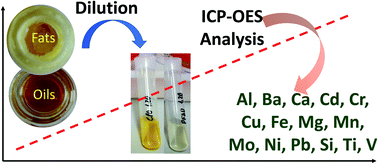Multielemental analysis of vegetable oils and fats by means of ICP-OES following a dilution and shot methodology
Abstract
The elemental analysis of vegetable oils as well as fats of animal origin through inductively coupled plasma optical emission spectroscopy, ICP-OES, according to a dilution and shot analysis method is reported for the first time. In order to introduce the diluted samples, a 5 μL sample volume has been injected into an air carrier stream and lead to a conventional pneumatic concentric nebulizer. A transient signal or peak has been obtained. The so-called high temperature torch integrated sample introduction system (hTISIS) has been used to lead the sample to the plasma and a conventional cyclonic spray chamber has been taken for comparison purposes. Before performing the analysis of the selected samples, some critical variables such as the speed at which the sample plug was delivered to the nebulizer, the injected sample volume and the nebulizer gas flow rate have been optimized. The sample dilution factor has also been evaluated and the best performance has been obtained when samples have been 1 : 20 diluted with xylene as solvent. An accuracy study has been carried out in which the hTISIS has provided satisfactory results using an external calibration approach in which xylene based standards have been used. In contrast, the cyclonic spray chamber causes matrix effects thus requiring the use of an alternative technique such as internal standardization or standard additions. In addition, the former system mitigates the impact of the analyte chemical form on sensitivity as it has been verified for silicon. Besides these two advantages, the hTISIS has also improved the analytical figures of merit over the cyclonic spray chamber by a factor between 4 and 10 whereas limits of detection have been improved by a factor included within the 1.1 and 7.3 range. Compared to a method based on sample digestion and further ICP-MS detection, the present protocol is simpler, faster, it provides information about a higher number of elements and, in some cases, it affords lower limits of quantification while it gives rise to similar confidence intervals. The hTISIS has allowed the accurate determination of Al, Ba, Ca, Cd, Cr, Cu, Fe, Mg, Mn, Mo, Ni, Pb, Si, Ti and V in solid fats as well as used and non-used oils.

- This article is part of the themed collection: Community Leaders: Gary Hieftje


 Please wait while we load your content...
Please wait while we load your content...